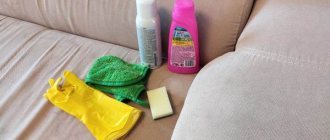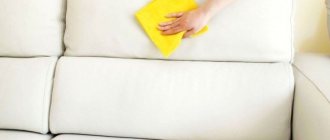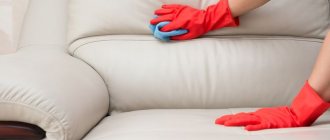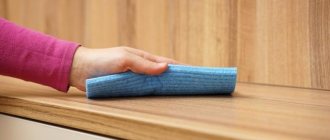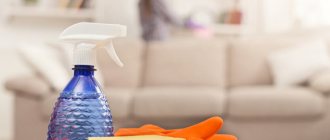Many people prefer leather furniture because it has many advantages. Leather sofas and armchairs are stylish, beautiful and easily fit into any interior. However, such furniture requires high-quality and careful care.
After some time of use, the question arises of how to clean a leather sofa at home so that it retains its attractive appearance for a long time.
You shouldn’t be overzealous and clean it with a damp cloth every day; unnecessary care can cause harm. Cleaning should be done when dirt appears, and the faster the stain is removed, the less likely it is that traces will remain.
How to clean a leather sofa
How to properly clean a leather sofa? The following sequence of actions must be followed:
- Vacuum the surface, being careful not to damage it with the plastic elements of the nozzle. Then the remaining dust is carefully wiped off with a soft cloth, this will help prevent dirt from penetrating into the material.
- Conduct a contamination analysis. A heavily soiled surface should be treated with a chemical or natural leather composition, and for minor stains a soap solution is sufficient.
- After the cleaning procedure is completed, the entire surface of the sofa is wiped with a dry cloth.
- To speed up the drying process, you need to wipe the sofa with a dry cloth and thoroughly ventilate the room.
- To consolidate the result, a fixing agent, such as a moisturizing conditioner, is applied to the skin, and the surface is thoroughly polished.
Before using a leather surface cleaner, including a chemical one, you should test its effect on a small area of leather.
The application of the cleaning product should be carried out in a circular motion, starting with less dirty areas, gradually moving to the most contaminated areas. This way you can get rid of streaks and prevent the spread of contamination across the surface.
Cleaning using technology
To remove fresh dirt from a leather sofa, you can use household appliances. The main thing is to choose a suitable nozzle that will not damage the structure of the material.
Before cleaning, you must use a vacuum cleaner to remove debris and animal hair from the surface of the furniture. Then apply the required amount of cleaning agent to the upholstery and treat the contaminated area using a soft bristle brush attachment.
For old and stubborn stains, use a steam generator, the tank of which is filled with water and a small amount of conditioner. This method allows you to not only clean, but also disinfect furniture, eliminating germs and unpleasant odors.
Note! Steam treatment is carried out at a distance of at least 5 cm from the upholstery, so as not to cause irreparable damage.
White leather sofa cleaning products
The pride of any owner is a white leather sofa. It looks much more impressive than dark, but also gets dirty much faster. In addition, most stains are much more difficult to remove from light-colored surfaces. To do this, use the following methods.
Milk
Cow's milk, which should be slightly warmed, can help remove fresh grease stains. The stain is wiped with a cotton swab dipped in milk and then wiped dry with a rag.
Vinegar
A weak vinegar solution can remove stains on white furniture. But you need to use it carefully, lightly moistening a cotton swab in the solution, and first testing the product on an inconspicuous area of the coating.
Dishwashing gel
This product can also be used to clean the surface of a white leather sofa.
Dirt is wiped with a sponge or soft flannel or microfiber cloth soaked in washing gel; the residue is removed with a damp cloth.
Ammonia
Ammonia can also cope with oily stains on white skin. The main rule in this case is to use it very carefully; during processing, the skin may dry out and crack.
This product can only be used on white leather; when cleaning a colored sofa, it can damage the surface.
Removing stains
You can clean stains from sofa upholstery at home using improvised means. The easiest way is to remove fresh stains, so don’t put off this work. Immediately after a stain appears, it should be treated.
Fat or oil
If grease or oil gets on the leather upholstery, you should not rub the sofa with a rag, this will only spread the grease over the surface and the stain will become larger in area.
To prevent the fat from being deeply absorbed, it is necessary to immediately cover the area of contamination with any product that could absorb the oil. This could be soda, salt, starch, baby powder. After a few minutes, the fat will be absorbed and the used absorbent will be carefully swept away from the sofa. Then you should wash off any remaining grease using dishwashing gel. Such gels contain substances that dissolve fat, so the product removes oil and grease stains very well.
Beverages
Stains from spilled wine, coffee, or tea must be removed immediately. You should try to blot up as much liquid as possible using napkins and cover the stain with salt or other absorbent substance. Then you should wash the area of contamination with soapy water.
If the stain is old, you should first try to wash the contaminated surface with soap. If a trace remains, it is cleaned with Vaseline. If this method does not work, you will have to resort to more radical measures - cleaning with ammonia solution. To prepare the solution, dilute a teaspoon of ammonia in a glass of water.
Blood
Fresh blood stains can be easily washed off from leather upholstery with cold water. If the stain is old, then first wipe it with a cold soapy solution and let it soak for about 20 minutes. Then wipe the upholstery with a dry cloth and treat it with a small amount of Vaseline.
Traces from pens, ink, felt-tip pens
These stains on leather upholstery can be easily removed with alcohol solutions. You can use vodka or diluted rubbing alcohol. Products made from genuine leather can be cleaned with nail polish remover; artificial materials cannot be treated with this product.
Chewing gum
First of all, you need to remove the dried gum mechanically. For easier separation, the cooling area must be cooled. To do this, you need to put ice in a thick bag and apply this “compress” to the upholstery of the sofa. The cooled gum can be easily removed with your fingers; you can use a blunt plastic spatula. But it is not recommended to use a knife; it can easily damage the upholstery.
Ketchup and other sauces
Table vinegar is suitable for removing traces of low-fat sauces. Take a 9% solution and dilute it half with water. Treat the stain with a solution using a soft sponge. Then wipe with a cloth moistened with clean water. Remains of moisture are removed with a dry cloth or napkins.
So, you can wash a sofa with leather upholstery and clean it from stains yourself. But it is still better to take measures that will reduce the risk of stains. You can periodically treat leather furniture with special products that form a thin protective film on the surface. This film will prevent dirt from penetrating deep into the pores of the skin, and it will be much easier to remove stains.
How to wash a leather sofa at home: removing stains from the surface
Stains on the sofa can be of different origins, especially if there is a small child in the house. And teenagers also love to lie around with food in front of the TV, so when dirt appears on the surface, you need to act quickly before the stain eats into the fabric base.
How to clean the coating from difficult stains and not spoil it?
You should know that you should not use abrasive products; you should also avoid any products that contain acid, alkali and chlorine. You also can’t wet or rub the surface too much, so you should immediately discard all brushes with hard bristles.
These simple tips will help you deal with different types of stains:
- It is better to remove the juice with a mixture of ammonia and vinegar. The cleaning solution is applied to the stain and left until completely dry, and then removed with a damp cloth.
- Fresh fat should be sprinkled with salt, then removed with a napkin.
- The most troublesome thing is caused by stains and stains from spilled coffee; it penetrates the surface very quickly. A vinegar solution or simple dish soap can help solve the problem.
- Fresh blood can be washed with a solution of laundry soap and cold water. With old blood it is a little more complicated; a one-time cleaning is not enough; you will need to repeat the procedure several times. For this case, there are two options for preparing a “cleaner”: an aspirin tablet dissolved in 200 ml of water or a tablespoon of salt added to 1 liter of water.
- Wine takes the longest to hatch. First you need to remove the remaining liquid with a rag, and then sprinkle the wine marks with salt. Then cleansing with alcohol is carried out. If white wine is spilled, you can do without salt.
During the cleaning process, you do not need to rub the stains; this will only increase the area of the problem and require more thorough cleaning.
Rules of care
In order to extend the life of furniture, it is necessary to comply with operating conditions and use a professional care product. It is better to place the piece of furniture in a room with moderate humidity, away from heat sources. The surface should be treated once a week. Excessive rubbing of the surface contributes to rapid wear.
Care includes:
- vacuuming from dust and crumbs, paying special attention to seams;
- wipe with a soft, damp cloth (microfiber);
- wipe with a dry cloth.
A competent approach to furniture care makes cleaning at home effective and safe. It is impossible to cope with some types of pollution without household chemicals.
Some more cleaning tips:
- Do not scrub the surface with hard sponges or brushes.
- Make sure that red wine, coffee, and paint do not come into contact with your skin. If this happens, immediately remove the stain with a damp cloth.
- Use balms that create a protective layer and increase the elasticity of the upholstery. Some types mask abrasions.
The dry cleaner will do all the work themselves if you have no experience in removing stains. In addition, it is not always possible to deal with old stains on your own.
Useful tips
Before you start cleaning, you need to make sure that the selected household chemicals are suitable for the surface of the furniture. To do this, test the balm on a small area. It is not recommended to use several products at the same time, so as not to damage the upholstery. When removing stains, move from the edge to the center, then there will be no streaks left. If the dosage of the balm is increased, do it gradually, allowing the skin to get used to it.
How to keep your skin looking pristine:
- ensure that the humidity in the room is 60-70%;
- remove products at a distance of 1 meter or more from heat sources;
- use protective covers and capes if the house is left without owners for a long time;
- keep pets away from the furniture;
- protect from exposure to ultraviolet radiation so that the material does not fade;
- Carefully ensure that the composition is suitable for a particular type of upholstery.
What should not be used for care
Even the most durable material does not last forever. Before you start cleaning, you need to know how to clean upholstery.
The material must not be cleaned:
- Aggressive agents (solvents, turpentine, alcohol, bleach).
- Running water. Tap water contains salts and heavy metals and has increased hardness. After treatment, stains remain on the upholstery, which are very difficult to remove.
- Rough mechanical impact. Cleaning is done with a soft cloth using smooth movements.
- Drying with a hairdryer or other heating devices is contraindicated.
- To prevent the material from fading, do not expose it to ultraviolet rays.
Any piece of furniture loves cleanliness, leather products especially. It is better to remove dirt immediately. Then it will be easy to do.
Fighting fungi and mold
A big problem for owners of leather furniture can be the appearance of mold and mildew. The cause of this trouble may be increased air humidity or liquid that has not been removed in time and got into the folds of the furniture. Often the first signs of fungus and mold appear in such hard-to-reach places.
- Vinegar will help cope with this problem. Wipe the mold areas with the solution, then remove any remaining acidic substance with a damp cloth and wipe the surface dry.
- You can also clean furniture with a Vanish type stain remover. The product is diluted in water, then applied to the stains with a rag or sponge.
- How and with what to clean a sofa that has mold in many places? Here you will need the help of professionals; it will be difficult to solve the problem on your own.
Do's and don'ts
Items made from eco-leather and other synthetic materials require careful care. Depending on the type of contamination, different cleaning agents are allowed.
The following can be dangerous for any product made from eco-leather or leatherette:
- excess moisture;
- exposure to high temperatures;
- cleaning with a steam generator;
- abrasives.
Chemical solvents should be used with caution. Some of them can damage the surface.
You cannot use powdered soda, brushes or hard sponges - they will leave scratches, dirt will penetrate deeper, and it will be impossible to get rid of them. If the surface is glossy, dull spots will remain on it after cleaning with abrasive agents.
Before using any substances, it is better to test on a piece of material or an inconspicuous area of the product!
How to care for leather furniture
Caring for leather furniture does not require much effort; it is quite unpretentious.
- The main thing is to ensure a normal level of humidity in the room, and also to avoid direct sunlight on the surface.
- In addition, it is necessary to regularly care for your skin using special products. If you do not have the opportunity to purchase an expensive chemical, use a folk recipe: beaten egg white is applied to a woolen cloth, which is used to wipe the previously cleaned surface.
- If abrasions appear on the sofa, “Liquid Leather” will help to cope with them. This is a water-soluble polymer that forms a thin film on the surface when applied and returns the material to its original color and shine.
If you follow the rules and recommendations for caring for leather furniture, you can maintain its luxurious appearance for many years.
Restoration of abrasions and scratches
You can make easy repairs to leather goods yourself. After the standard cleaning procedure, let the material dry and carefully inspect it in good lighting from different angles. Over time, scratches and worn spots form on any surface. Under the influence of cleaning agents, the painted surface also becomes lighter. To restore the appearance, you can use special means. Whitish spots are restored to richness with cream paint for leather products. Treatment with a spray or wipes soaked in a restorative composition based on wax or silicone helps to hide cracks.
How to properly wash a leatherette product?
Eco-leather does not need to be wet much; all work is carried out with a wrung-out cloth. For washing you need a soft sponge and two dry cotton or microfiber cloths. You need to wipe off the dust first so as not to roll the fluff across the surface.
The procedure is as follows:
- Apply a small amount of cleaning solution or foam with a sponge. Rub gently.
- Remove the composition with a clean damp cloth.
- Wipe with a dry cloth to remove any remaining moisture.
- Apply a protective agent with silicone - it softens the surface, adds shine and forms a film that prevents contamination. Be sure to wipe off excess with paper towels.
We recommend: How to soak salted herring quickly: in water, milk, tea
Unfortunately, housewives also have to wash more complex stains. Tips for removing common stains will help keep your white finish clean.



